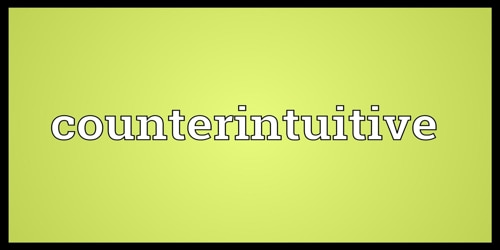Counterintuitive
The definition of counterintuitive is something that goes against what you believe would be logical or something that goes against common sense. If something is counterintuitive it means it’s the opposite of “intuitive” — in other words, it’s not easily understood in an instinctive, unconscious way. A red light for “go” and a green light for “stop” would be highly counterintuitive, for example.
Scientifically discovered, objective truths are often called counterintuitive when intuition, emotions, and other cognitive processes outside of deductive rationality interpret them to be wrong. However, the subjective nature of intuition limits the objectivity of what to call counterintuitive because what is counterintuitive for one may be intuitive for another. This might occur in instances where intuition changes with knowledge. For instance, many aspects of quantum mechanics or general relativity may sound counterintuitive to a layman, while they may be intuitive to a particle physicist.
In social and personality psychology we study phenomena that regular people reflect on and speculate about too. A connection to everyday lived experience is almost definitional to our field, whether you think it is something that we should actively pursue or just inevitably creeps in. So we have an extra source of intuitions – the intuitions of people who are living the phenomena that we study. Which includes ourselves, since social and personality psychologists are all human beings too.
Many scientific ideas that are generally accepted by people today were formerly considered to be contrary to intuition and common sense.
Another counterintuitive scientific idea concerns space travel: it was initially believed that highly streamlined shapes would be best for re-entering the earth’s atmosphere. In fact, experiments proved that blunt-shaped re-entry bodies make the most efficient heat shields when returning to earth from space. Blunt-shaped re-entry vehicles have been used for all manned spaceflights, including the Mercury, Gemini, Apollo, and Space Shuttle missions.
A classic example of the intuitive/counterintuitive divide can be found in computers: today they’re so easy to use a toddler can handle them; early ones were so counterintuitive they remained a head-scratching mystery to all but a few techies. Writing tip: note that counterintuitive is one of those words that used to be commonly hyphenated (like “nonetheless” and “secondhand”) but is now generally spelled as a single word.
For another example, when intuition systematically leads people to make consequentially bad decisions it can be important to document that and understand why. But being counterintuitive for counterintuitive’s sake? If intuitions vary widely and so do results, across contexts and populations — then we run the risk that placing too much value on counterintuitive findings will do more to incentive rhetorical flash than substantive discoveries.
Many examples of cognitive bias, such as:
- The clustering illusion that suggests that significant patterns exist in a set of random points when no other cause than chance is present
- That alignments of random points on a plane are vastly easier to find than intuition would suggest
Information Source:
















